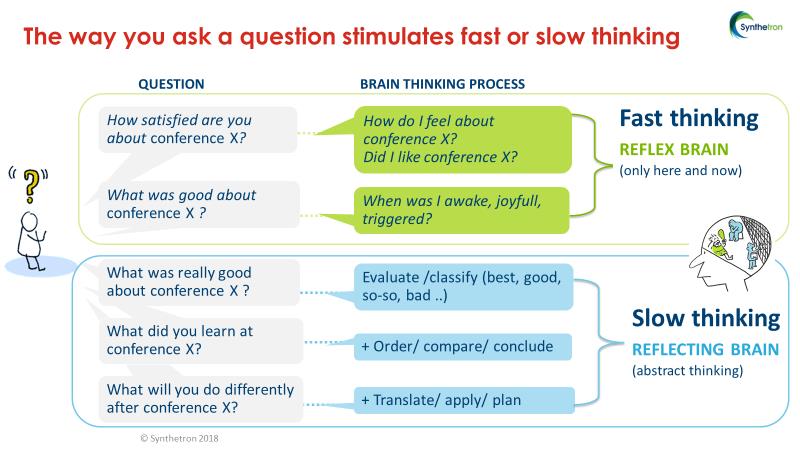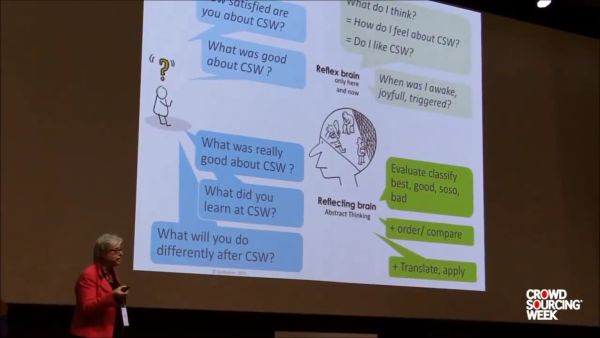 Ask good questions and generate intelligent insights.
Ask good questions and generate intelligent insights.
The biggest revelation we had from the last 10 years of hosting online crowdsource dialogues (1) with employees for organisations is that a single word in a good question can make all the difference!
When there are 100 people online for one hour, a badly posed question would waste 700 valuable brain-minutes and an opportunity to learn would be lost. On the other hand, posing good questions generates energy, stimulating all participants to join the conversation. A good question touches hearts and minds. Most importantly a good question uncovers valuable actionable insights and creates highly engaged participants.
Key to formulating a good question is knowing what you are looking for. What type of answers are useful and valuable? What type of thinking do you want to promote with respondents? When you are looking for wisdom you need to ask “slow-thinking” questions.
Avoid the “fast-thinking” trap.
We all intuitively know that there are two types of questions, those that are easy to answer and those that require you to think and reflect before answering. Nobel prize winner, Daniel Kahneman pointed out in his seminal work, Thinking Fast and Slow, that people use two types of brains to answer a question. First there is the more primitive reflex brain that stimulates “fast-thinking”. It is superfast, thinks instantly and operates from the here and now. It uses instinct, patterns, biases and analogies. This reflex brain is a great engine we use all the time to find quick answers to day to day questions such as “can I cross the street now?”. The other is the reflecting brain. This is “slow-thinking” and needs to be prompted and activated. It helps us to think thoroughly, more in the abstract and systemically. We probably all recognise situations where we needed to create the conditions – white space, a shower, a walk – to concentrate so as to be able to think something through. This is when you want to tap into the deep slow-thinking capacity of your reflecting brain
Daniel Kahneman points out that human brains are fundamentally lazy and prefer using their fast reflex brain to quickly answer questions. This means that when hearing a question, the fast brain tends to take over and formulate an answer. On top of that, as he explains, the fast brain is prone to many biases. If you are seeking wisdom or profound advice from a person or group of people, your question needs to trigger their slow-thinking (reflective) brain. Remember the slow-thinking brain is lazy and will only start the deep thinking if prompted. So, when you are seeking wisdom avoid the fast-thinking trap. and formulate slow-thinking questions
Slow-thinking-questions vs. fast-thinking-questions
The image below helps to understand the difference slow-thinking-questions and fast-thinking-questions. All questions seek feedback on the value of a conference participation. The specific formulation of each questions on the left triggers a different thinking and emotional process illustrated to the right. See how more slow-thinking triggering questions (lower left) induce deeper thinking, stimulating the reflecting brain.

- Asking a fast brain question like, “How satisfied are you about conference X?” will induce the fast brain to instantly collect a quick answer by collecting reflexes and feelings of joy or boredom. The fast brain will generate an answer to: “Did I like this conference?” It’s a quick, top of mind answer.
- Asking a slow brain question such as “What did you learn at conference X?” will request the slow brain to start working: one has to remember what information was shared, compare this with their current knowledge, evaluate the new information and its value, and make a conclusion. This is a very different thinking journey!
Asking slow thinking questions cannot happen without creating the right environment. One where there is:
- a safe space to speak up
- an enquirer who is respectful and sincerely interested
- a question phrased to give energy and fit into the flow of the dialogue.
Knowing what type of outcome you looking for determines the choice between a slow or a fast-thinking question. Are “top of mind perceptions” valuable or do you want to get deeper wisdom?
You can easily test the slow or fast thinking level of your question by answering it yourself. You will discover if you are using the instant “fast-thinking” or need more time using the “slow-thinking” part of your brain.
Watch Joanne talking about asking the right question in this video:
Post by Joanne Celens and Susan Anglin

Joanne Celens (left) is the CEO of Synthetron. Joanne studied business (KULeuven) and International studies at Johns Hopkins University. Contact Joanne at joanne.celens@synthetron.com
Susan Anglin (right) is a Consultant for Synthetron Canada. Susan has earned her MBA and the PMP designation (Professional Project Manager). Contact Susan at susan.anglin@synthetron.com
This post was first published by Bob Tiede on his blog – https://leadingwithquestions.com/blog/
Synthetron helps leaders and managers to engage and get answers to important questions by facilitating moments of meaningful and efficient 1 hour online dialogue with employees /stakeholder groups.





